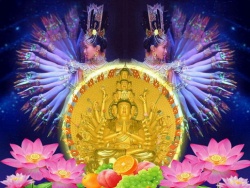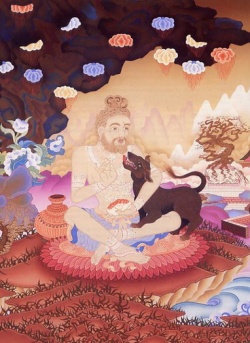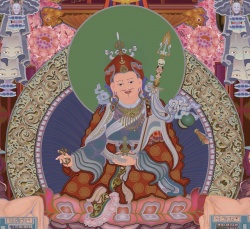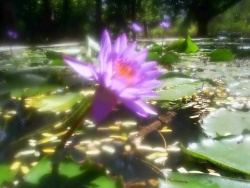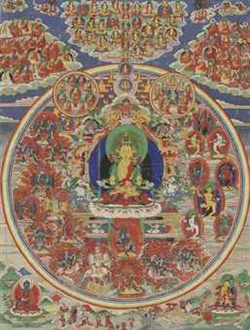The Six Primary Elements are composed of three aspects
1. Essence: The common nature of the cosmos Form: The forms or shapes of objects and living beings Usage: Languages, movements, and the use of all things Everything in the universe has Essence, Form and Usage. Our mind divides things into these three aspects when in reality they do not exist separately. Without one, the other two cannot exist. Therefore, by examining one aspect we can understand all three. Even though there are countless creatures existing under countless forms and qualities in the universe, they all have the same essence or life force, the core of all things. Without the Forms, the Essence cannot manifest itself. The Essence and the Forms represents inaction and action of the unique existence. The Essence is also Buddha’s nature. Therefore, it is in every living being and in every form. To realize Buddha’s nature within oneself and to become one with it, one must first observe the Forms of the Four Mandalas.
2. The Four Mandalas
Mandala means fully rounded, immensely wide and large. The Four Mandalas represent the myriad of shapes in the infinite universe manifested by the Six Primary Elements. A. Maha Mandala, generally speaking, expresses the whole universe, in which viewed broadly, human beings and all living things made of the six primary elements, maintain harmony and interdependence with each other. It is the body of all beings in the ten directions of the universe, and the outside appearances of all doctrines. Strictly speaking, it is the majestic form of Buddha and Bodhisattva, which is expressed in the carved or painted statues. B. Samaya Mandala: Samaya means vow.
Viewed broadly, it is all the mechanical tools of the universe for the common use of living beings. In a broader meaning, it is the distinct character of every principle. It is also mountain, river, tree, grass, etc. In the narrow sense, Samaya Mandala is the symbol used by Buddha and Bodhisattva such as the lotus, jewels, a branch of willow tree, the diamond scepter... to represent their respective vows, or their characteristics in their work for the salvation of humanity.
C. Dharma Mandala: Broadly speaking, it is all the sounds, speeches, images, makes and symbols in the universe. More specifically, it is the seed syllable or the Dharani of Buddhas and Bodhisattvas. The seed-syllable is a letter of the alphabet that represents the essence of Buddhas and Bodhisattvas. The seed syllable of Mahavairocana is “A”- the seed of Vajrapani is “Hum”. A Dharani is the secret formula and the titles of Buddhas and Bodhisattvas; it also represents all the written text in the Sutra. D. Karma Mandala: Karma means action towards a goal. Thus, broadly speaking, it is all the actions of all living things. Its narrow meaning is all the actions of Buddhas and Bodhisattvas for the salvation of humanity.
These four Mandalas exist simultaneously. They are within the Buddhas and human beings. The four Mandalas of the Buddhas do not separate from the four Mandalas of human beings, and vice versa. That is why it is mentioned in the Sutra as the Four Inseparable Mandalas. 3. The Three Secrets The essential method of practice in Secret Buddhism is the transcendental meditation on the Three Secrets of body, speech, and mind. As mentioned above, the six elements are the life force of all living beings and of the Buddhas, and the four Mandalas are their forms. The three realms of doctrines relate to the “Body Secret” of Mahavairocana. All sounds pertain to His speech, and consciousness pertains to His mind.
For the adept, forming a seal symbol with the fingers relates to the “body secret,” reciting the Dharani relates to “speech secret”, and dwelling in meditation relates to the” mind secret”. The difference between Buddha and living beings is purity and impurity, wisdom and ignorance, liberation and bondage. To experience the Buddha nature within yourself and that of the universe, one has to practice meditation on the Three Secrets. Forming the Mudra purifies karma from action (body karma). Reciting the Dharani purifies karma from speaking (speech karma). Focusing on the yantras or Mahavairocana or the seedsyllables eliminates ambition, and purifies the thought (mind karma).This practice has two major stages:
The first stage is called the “upholding of the granted Three Secrets”. When the practitioner has his body, speech, and mind under control, his mind will become clear and still like water, and he will then be able to receive Mahavairocana’s holy bright light shining into his heart. This is called “granting the spiritual force”. By feeling the spiritual force in his heart, the devotee is receiving and keeping it. This expresses the unity of the Buddha's great compassion and the faith of the practitioner.
The second stage is the “Yoga meditation on the Three Secrets”. The bestowal of the force is like the sunlight from the Buddha's radiance shining on the water-like mind of the practitioner, and the receiving of empowerment is the feeling of the sunlight from the Buddha. When the practitioner has mastered the first stage, the light from Mahavairocana and the one from the practitioner will be totally fused together. (Yoga = union). This is the end stage of successful practice.
The philosophy of Shingon pays much importance to the Three Secrets. All things have body, speech and mind. We tend to think that only human beings can talk. However, in this world, other living beings can also talk. We may not have heard them and we do not seek to hear them, but they are not voiceless. We cannot hear them because we do not know how to listen to them. Shingon's idea is that the body, speech and mind of all beings are the Three Secrets of the universe.
Trees, plants, grass, flowers, and vegetation do communicate. The rustling and the cracking sounds of leaves and branches sometimes sound like people singing, debating or shouting in anger. When we have a chance to sit quietly in a deep forest and listen closely, the trees sound as though they are speaking with each other, and soliciting in many ways. For the poet and the spiritual person the ripple of mountain streams sounds like a soft melody, complete with tones and images. For us, sitting on the beach, the waves seem to uproar or bustle noisily as they slap against the shore.
Birds seem to be happy through their chirping and singing.
Thus nature is not silent and human language is simply one of the many languages in the universe. By cultivating ourselves and keeping the precepts properly, we will have a pure heart and we will be able to understand the sounds of all things. We will also be able to see and hear the Deities, Saints, and Celestial Beings. A pure and peaceful heart is required to open up the centers of consciousness in the body in order to receive the hidden secrets of the universe. Most people prefer to learn from textbook only. Such learning leads to a superficial knowledge of nature as it leaves aside hidden metaphysical principles and mystical realms.
It conceals the ultimate out of reach goal, as people are not able to see or to even think about it. In fact, this is exactly what people should know. Everything has a mind and language beside their forms. It is the mind that gives life to all things, expressing itself through the form, sign and language. Therefore nothing is silent. Silence is the language inside the mind that sometimes provides perfect communication. From now on, we should not discriminate or have contempt between living beings and living things. Anyone who thoroughly penetrates the body, speech, and mind Secrets will immediately reach the Buddha’s rank. It does take a long time to carefully observe and learn from nature to realize its mysteries.
4. The Ten Stages of Mind’s Development The Great Vehicle Buddhism believes that dogmatic differences between sects, schools, and religions are useful and necessary for different persons with different abilities and perspectives. Some dogmas are suitable for the layperson while others are reserved for the selected few that are more advanced. But all dogmas and religions are constructive in generating peace and happiness and in advancing human spirituality. There is no right or wrong doctrines but tailored ones for the novice and untailored for the adept. Kukai (or Kobo 774-835) has compiled the complete set of Secret Buddhism Sutra. In the Mahavairocana Sutra, he has analyzed the development of the human mind and classified it into ten stages, similar to the development stages of the lotus flower.
1) Abnormal birth - the Goat’s mind The lowest stage of consciousness and behavior is impulsive and instinctual. Here the person lives blindly, acting like sheep, and devoid of moral and spiritual values, being barely distinguishable from animals. This realm is not much different than beings in the realms of hell, ghosts and beasts. His nature is different from other good people. In India, they are called goats, the most dumb and stupid animal. The mind at its first stage is compared the lotus's germ buried in the mud.
2) The common mind-The follower (the Human vehicle) The second stage is characterized by an emergent ethical awareness coupled with naivety and ignorance. Individuals at this level have sensitivity towards others and practice simple precepts without understanding much of the doctrine. It is the common stage for humans. The Buddhist observes the 5 precepts (not to kill, not to steal, not to indulge in sexual misconduct, not to lie, and not to drink) to avoid karma of speech and body. The Confucian lives by the teaching on the three relations guiding the behavior between the king and its subject, between father and son, and between husband and wife, and by the five ethics (benevolence, righteousness,
propriety, wisdom and fidelity). At this stage, the Shingon follower begins the practice of meditation on the Three Secrets. This step is similar to the lotus flower getting its fragile stem out of the mud.
3) The fearless mind (Divinity Vehicle) This is the stage for people in the heaven realm, where they strive for extraordinary power. This is the realm of the young man that has no more fears as he has passed the worrying stages. He has successfully avoided the realms of hells, animals and hungry ghosts and is having a glimpse of the heaven realm. He may avoid downfall by keeping the precepts and by staying close to the sage. Belonging to this stage are the genuine Taoist and Brahman followers. True practitioners of Shingon at this stage have made good progress in their meditation on the Three Secrets. This is the picture of the lotus with its stem above the water and into the sunlight.
The Wheel Of Life
Human;s
Demons
Heaven
Hell
Atula
Animals
4) The altruistic mind- Skandaism (Intellectual vehicle) At the fourth stage a human being understands the no-soul doctrine and realizes that the temporary ego consists merely of the five skandhas or aggregates: form, feeling, ideas, actions and consciousness. Such an individual is a shravaka (a Hearer of the Word). This is the higher spiritual life of the practitioner in the Theravada School, Kou-Cha-Shu and Jo-Jitsou-Shu sects. At this level, one forgets his ego and is looking for the truth. They realize that a strong sense of ego is the cause of delusion as ego itself is also a delusion and therefore must be abandoned. This stage is similar to the lotus’ bud, waiting for the sunshine to blossom into a beautiful flower.
5) The Human mind – (Prateyka or the Self-Enlightened) People at this level understand the cause of suffering, or thirst for embodied existence, and seek on the one hand, to eliminate the creation of new karma and strive on the other for nirvana. Such are the Prateyka Buddhas, who know how to win enlightenment for themselves, but lack the upaya or skillful means to help others towards the same goal. This is considered a selfish attitude. A Prateyka Buddha is one who, through realization of the causes and conditions of greed, can get rid of them. There are 12 linked conditioned causes, the first one being ignorance. In the Shingon system, the fourth and fifth stages are the realm of one who meditates upon the unreal and realizes that all things are reflections of images on a mirror. The reflection of the moon and the lotus, no matter how clear it appears in the water, are also unreal. Life is also a dream that ends quickly.
6) The Great Vehicle mind - Benefiting others The sixth stage witnesses the translation of wisdom into compassion, the first step in the Mahayana or Great Vehicle. These three stages represent a fundamental turning of consciousness away from the distractions of a transient world, which pretends to permanence, towards the seemingly less certain but more real world of spiritual striving. At this stage, the Buddhist of the Great Vehicle system is a philanthropist. According to the teaching of Hosso-Shu (Jap.) or Fa-Shiang-School (ch.), although life is unreal, thought is not. Thoughts create all things.
A person's appearance is the result of his thoughts, which dictate his life destiny to be either good or bad. A person with bad thoughts can never have a noble and pure life. By keeping the knowledge of the secret principle of liberation for ourselves, we will not become Buddha. Helping others is also helping ourselves. If the Buddha does not use the doctrine to save people from their miseries he does not deserve to be called Buddha, The Great Compassionate One. This is similar to the lotus' stems being held under water by grasses. Other lotuses joined their stems together to set it free and let it rise above the water.
7) The mind of nothingness. Enlightenment In the seventh stage an individual realizes that the mind is unborn, without beginning or ending. The person has reached the philosophy of “True Emptiness” meaning that things are not real and not unreal. This is the stage of the Middle Way doctrine (Madhyamika) of the Three Treatises School (Sanronshu-Jap.). Persistent meditation on the eightfold negation: No life, no death, no coming, no going, no similarity, no difference, no existence, and no emptiness elevate the mind from the common to the supreme and peaceful heavenly realm of the Middle Way Thought. The cultivators of the 6th and 7th levels of the Shingon Sect reach Samadhi (Yoga: Unity with God) freely and easily. This stage is compared to the lotus flower rising above the water. The lotus is not completely real but it is not a mere reflection either.
8) The Unique Way Mind
The eighth stage is a subtle shift in consciousness, which is represented by the Tendai School and its view of Buddha as Omnipresent Reality. Tendai considers one religion as the foundation of all. All things are equal. They all have Buddha nature in them and all things can become Buddha. This is compared to the beautiful lake full of lotuses bathing in the sun.
9) The Non-Self Mind
The ninth stage is the epitome of Secret Thought according to Kukai, for The Kegon School embodies this stage. The ninth stage goes with the doctrine of Avatamsaka (Hoa Yen), the highest principle of Hinayana Buddhism. Here one recognizes the interdependent origination of the realm of truth and law, beyond which lies full realization and enlightenment. It explains that the absolute is the same as the relative and that's why the mind does not keep its own character. This level of thought is compared to the lotus flower at its brightest and most beautiful stage as if it has in itself infinite subtle compassions.
10) The Dignified Mind. (The Diamond Vehicle)
The tenth stage –is a transcendence of all stages. It is the complete comprehension of Shingon, the True Word, which means the union of the individual's mind and body with the mind and body of Mahavairocana. At this level, one becomes Buddha, as he understands the Three Secrets of body, speech and mind. It is not enough to enjoy the lotus, or to watch it grow from a seed to a full flower. We must see the internal dynamic and the wonderful activities behind its appearance. We must know that the lotus has a Buddha Nature identical to ours.
